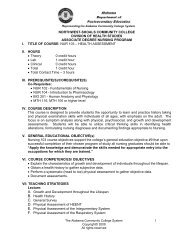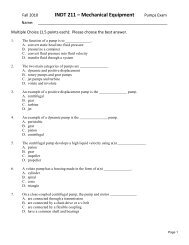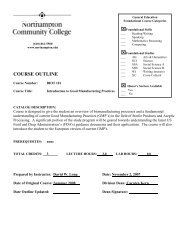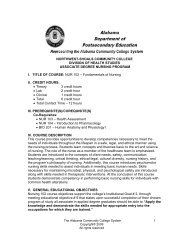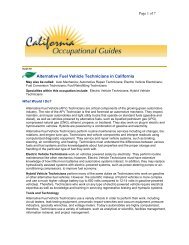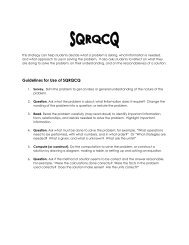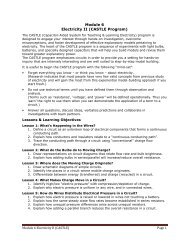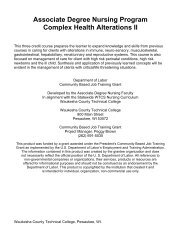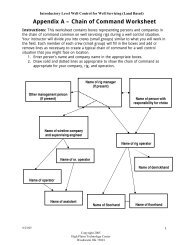7. Open the valve by turning the h<strong>and</strong>le to line up with the tubing. What happens to theload of books?8. Summarize your observations: You lifted a heavy weight, overcoming a large force ofgravity, a short distance by using a (larger, smaller) ______ force over a (longer,shorter) _________ distance.9. Next you will make measurements to quantify these observations. Record yourmeasurements in the Table 1. Measure the distance the small piston moves as youmove it from a starting position at the largest graduation mark to the zero mark. Use aruler, not the graduations on the syringe. This is Distance in.10. Pull out the small piston to the largest graduation mark. Now measure the force requiredas you push in the piston. Use a force sensor if available. If not, use another method,such as holding the syringe vertical <strong>and</strong> piling on stackable lab weights. This result,expressed in Newtons is Force in . Record this measurement in Table 1.Table 1Syringe Force in Distance in Force out Distance out AMA IMA Work in Work out Efficiency6 ccForce in <strong>and</strong> Distance in are the force <strong>and</strong> distance involved in operating the small syringe.Force out is the weight of the stack of books, <strong>and</strong> Distance out is the distance they were liftedas a result of one stroke of the small piston.Calculating Work is described in Activity 4.See Mechanics <strong>Module</strong>:AMA (actual mechanical advantage),IMA (ideal mechanical advantage),Efficiency11. Open the valve to lower the load. Then close the valve again.Note the position of the large piston that supports the books.12. Pump the small piston for 5 strokes. Count the strokes, <strong>and</strong> use a ruler to measure thedistance the piston moved. Also note the volume of fluid that entered the syringe. Dividethe distance by the number of strokes to find the distance out for 1 stroke13. Repeat the above measurements for some or all of the other small syringes.14. Find the AMA, IMA, Work in , <strong>and</strong> Workout <strong>and</strong> record your results in Table 1.15. Is the efficiency different for different systems?<strong>Module</strong> 4 Student Guide <strong>Fluids</strong> & <strong>Thermodynamics</strong> Page 20
Relating Force, Area, <strong>and</strong> PressureThis experiment is a study of how the variables force, area, <strong>and</strong> pressure are related.In this experiment we will produce the same amount of pressure four different times byapplying force to four different syringe pistons. The amount of pressure created will be justthe amount needed to lift a stack of books on the hydraulic jack, <strong>and</strong> is thus the same eachtime. Each small piston has a different cross-sectional area, <strong>and</strong> requires a different force toproduce the required pressure.The force, area, <strong>and</strong> pressure are related by a simple formula that may be discovered usingthis apparatus.1. Set up <strong>and</strong> bleed the system as described previously.2. Carefully balance several large books on the platform of the large piston. Take care toposition the books so that they do not lean in any direction.Caution! To prevent breakage, do not pump the piston above the 40 cubic centimeter markat any time during the experiment3. If a pressure sensor is available, connect it to the sidearm of part (i), which is connectedbetween parts (f) <strong>and</strong> (g), as shown in the Figure 1.4. With the smallest piston installed on the sidearm of the tee in part (d), measure theforce required to push in the plunger <strong>and</strong> lift the stack of books. Use a force sensor ifavailable. If not, use another method such as holding the syringe vertical <strong>and</strong> piling onstackable lab weights. Express the force in Newtons.5. Find the cross-sectional area of the small syringe. This may be done by measuring theinside diameter of the syringe, <strong>and</strong> using the formula for the area of a circle. A moreaccurate method is to use a ruler to measure the graduated portion of the syringe, <strong>and</strong>to note the volume of that portion. A formula for the volume of a cylinder, allowscalculation of the area.Volume = Area x Length6. Convert the area to square meters7. Record the pressure if a pressure sensor is available.8. Repeat the above steps for all four small syringes.9. Make a graph displaying the (area, force) data pairs from the four small syringes. Areashould be plotted along the horizontal axis, <strong>and</strong> force along the vertical axis.A straight line passing through the origin should show the pattern of the data. Usetechnology or traditional techniques to determine the equation of this best-fit line.The slope of the line is constant, <strong>and</strong> the pressure was also constant in this experiment.It seems plausible that these two facts are related. In fact, the slope is Force / Area,which is the definition of pressure.10. If a pressure sensor was available during this experiment, compare the pressure to theslope, <strong>and</strong> comment. (If the pressure sensor is calibrated in units of Pascals, (Pa), notethat one Pascal is the same as one Newton per square Meter.)<strong>Module</strong> 4 Student Guide <strong>Fluids</strong> & <strong>Thermodynamics</strong> Page 21



